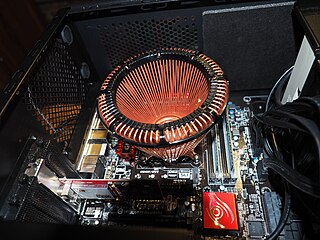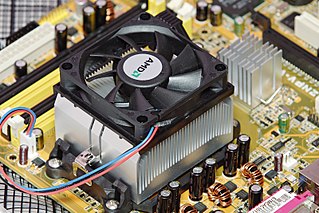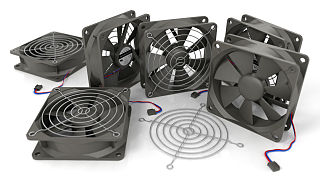
The Pentium III brand refers to Intel's 32-bit x86 desktop and mobile CPUs based on the sixth-generation P6 microarchitecture introduced on February 28, 1999. The brand's initial processors were very similar to the earlier Pentium II-branded processors. The most notable differences were the addition of the Streaming SIMD Extensions (SSE) instruction set, and the introduction of a controversial serial number embedded in the chip during manufacturing.

In computing, overclocking is the practice of increasing the clock rate of a computer to exceed that certified by the manufacturer. Commonly, operating voltage is also increased to maintain a component's operational stability at accelerated speeds. Semiconductor devices operated at higher frequencies and voltages increase power consumption and heat. An overclocked device may be unreliable or fail completely if the additional heat load is not removed or power delivery components cannot meet increased power demands. Many device warranties state that overclocking or over-specification voids any warranty, but some manufacturers allow overclocking as long as it is done (relatively) safely.

A quiet, silent or fanless PC is a personal computer that makes very little or no noise. Common uses for quiet PCs include video editing, sound mixing and home theater PCs, but noise reduction techniques can also be used to greatly reduce the noise from servers. There is currently no standard definition for a "quiet PC", and the term is generally not used in a business context, but by individuals and the businesses catering to them.

Case modification, commonly referred to as case modding, is the modification of a computer case or a video game console chassis. Modifying a computer case in any non-standard way is considered a case mod. Modding is done, particularly by hardware enthusiasts, to show off a computer's apparent power by showing off the internal hardware, and also to make it look aesthetically pleasing to the owner.
Zalman Tech Co. is a South Korean software engineering company manufacturing aftermarket desktop computer products focusing on cooling enhancement.

Computer cooling is required to remove the waste heat produced by computer components, to keep components within permissible operating temperature limits. Components that are susceptible to temporary malfunction or permanent failure if overheated include integrated circuits such as central processing units (CPUs), chipsets, graphics cards, hard disk drives, and solid state drives.

Arctic Silver Inc. is a privately owned engineering corporation which develops and manufactures thermally conductive compounds and thermal adhesives for the application of heat sinks to high-powered electronic components such as processors, LEDs, chipsets and other electronic devices. Founded in 1999, the company's facilities are located in Visalia, California, US.

A computer fan is any fan inside, or attached to, a computer case used for active cooling. Fans are used to draw cooler air into the case from the outside, expel warm air from inside and move air across a heat sink to cool a particular component. Both axial and sometimes centrifugal (blower/squirrel-cage) fans are used in computers. Computer fans commonly come in standard sizes, such as 92 mm, 120 mm, 140 mm, and even 200–220 mm. Computer fans are powered and controlled using 3-pin or 4-pin fan connectors.

A CPU shim is a shim used between the CPU and the heat sink in a computer. Shims make it easier and less risky to mount a heatsink on the processor because it stabilizes the heatsink, preventing accidental damaging of the fragile CPU packaging. They help distribute weight evenly over the surface.

Haswell is the codename for a processor microarchitecture developed by Intel as the "fourth-generation core" successor to the Ivy Bridge. Intel officially announced CPUs based on this microarchitecture on June 4, 2013, at Computex Taipei 2013, while a working Haswell chip was demonstrated at the 2011 Intel Developer Forum. Haswell was the last generation of Intel processor to have socketed processors on mobile. With Haswell, which uses a 22 nm process, Intel also introduced low-power processors designed for convertible or "hybrid" ultrabooks, designated by the "U" suffix. Haswell began shipping to manufacturers and OEMs in mid-2013, with its desktop chips officially launched in September 2013.

Cooler Master Technology Inc. is a computer hardware manufacturer based in Taipei,Taiwan. Founded in 1992, the company produces computer cases, power supplies, air and liquid CPU coolers, laptop cooling pads, and computer peripherals. Alongside its retail business, Cooler Master also is an original equipment manufacturer of cooling devices for other manufacturers, including NVIDIA, AMD, and EVGA. The company has sponsored major eSports events. Some of Cooler Master's products have won awards including the iF product design award.

LGA 2011, also called Socket R, is a CPU socket by Intel released on November 14, 2011. It launched along with LGA 1356 to replace its predecessor, LGA 1366 and LGA 1567. While LGA 1356 was designed for dual-processor or low-end servers, LGA 2011 was designed for high-end desktops and high-performance servers. The socket has 2011 protruding pins that touch contact points on the underside of the processor.
Noctua is an Austrian computer hardware manufacturer of CPU coolers and computer fans with a primary focus on the enthusiast market. The company's inception occurred in 2005 through a joint venture partnership between the Austrian company Rascom Computer distribution Ges.m.b.H., established in August 2000, and the Taiwanese cooling specialist Kolink International Corporation.

Socket AM3+ is a modification of Socket AM3, which was released on February 9, 2009. AM3+ was released in mid-2011 designed for CPUs which use the AMD Bulldozer microarchitecture and retains compatibility with processors made for AM3. The Vishera line of AMD CPUs also all use Socket AM3+. It is the last AMD socket for which Windows XP support officially exists.

Arctic GmbH, formerly known as Arctic Cooling, is a German, Swiss-founded manufacturer of computer cooling components, mainly CPU and graphics card coolers, case fans and thermal compound. Since 2010, Arctic expanded its business by starting a range of products to cater other consumer demands beyond that of computer cooling hardware. Nowadays, Arctic also offers various consumer products—spanning audio, home entertainment and computer peripherals. In 2012, Arctic was nominated as one of the finalists in the annual PCR Awards.

GELID Solutions Ltd. is a designer and manufacturer of CPU and VGA coolers, chassis fans, thermal compounds, accessories and other equipment for computers and electronic devices. The company is based in Hong Kong and has multiple manufacturing facilities in Mainland China and Taiwan.

Socket AM4 is a PGA microprocessor socket used by AMD's central processing units (CPUs) built on the Zen and Excavator microarchitectures.

LGA 1700 is a zero insertion force flip-chip land grid array (LGA) socket, compatible with Intel desktop processors Alder Lake and Raptor Lake, which was first released in November 2021.

Socket AM5 is a zero insertion force flip-chip land grid array (LGA) CPU socket designed by AMD that is used for AMD Ryzen microprocessors starting with the Zen 4 microarchitecture. AM5 was launched in September 2022 and is the successor to AM4.



















